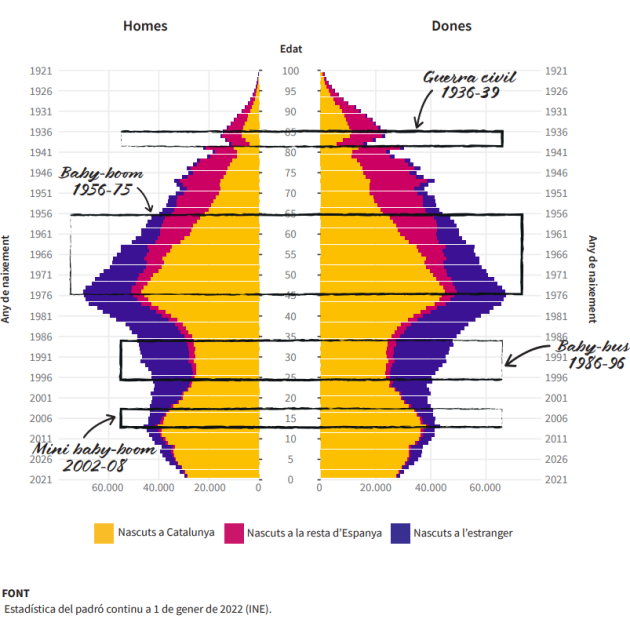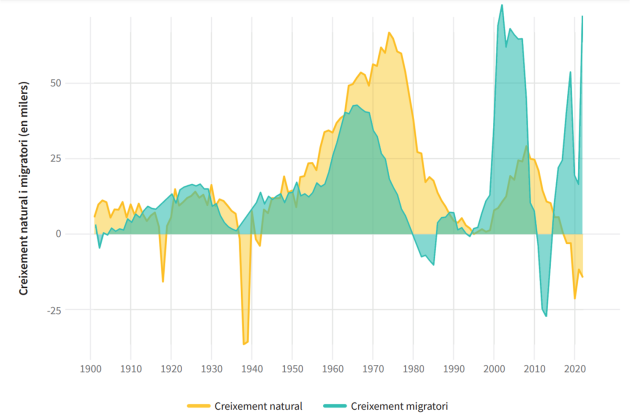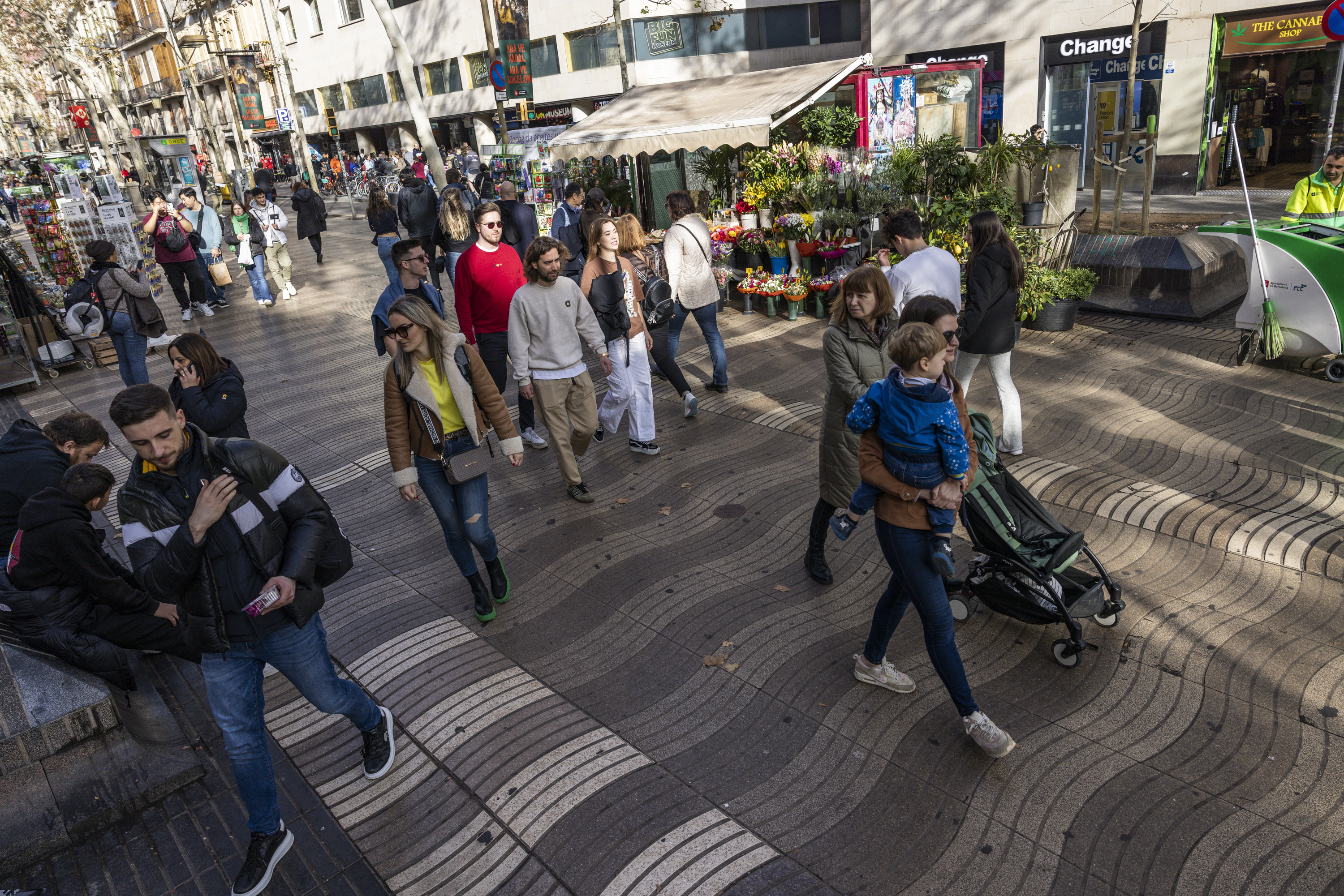Two out of three every residents of Catalonia are either immigrants or the children of immigrants, according to the data from the publication La Catalunya dels vuit milions ("The Catalonia of Eight Million") issued by the Centre d'Estudis Demogràfics (CED), based at Barcelona's Universitat Autònoma. Specifically, 65.8% of the Catalan population have either moved to Catalonia themselves, or their parents did so - migrating either from some other part of the Spanish state, or internationally. The work also highlights that 21st century migration has brought 1.5 million people to the country, compared to the population increase of 200,000 people that is due to natural population growth. Thus, it concludes that it is immigration that explains Catalonia's current population growth. In 2021, there were 2.8 million Catalan residents born outside Catalonia.
The evolution of the migratory balance is marked by four great waves: two in the 20th century (1910-1929 and 1950-1976) bringing immigrants from the rest of the Spanish state; and two more (2000-2008 and 2016-2022) characterized by international immigration. The first two waves brought 455,000 and 1.3 million people to Catalonia, respectively. In other words, they contributed 76% and 55% to the total population growth in these periods. In terms of 21st century immigration, it has contributed 1.5 million people.
The demographic evolution of Catalonia
The CED study asserts that without this "extraordinary" weighting of migratory waves "we would not understand" the country's demographic evolution, and nor its economic, social or cultural evolution. The report also explains that Catalonia's population growth has occurred "in bursts", closely related to economic cycles. The migratory balance is the main component of this increase, since natural population increase was the key element during the 1960s and until the first half of the seventies thanks to the well-known Baby Boom - which started and ended later in Spain, for social and historical reasons - and since natural increase has been losing importance due to the decline in the birth rate.
Migration from other parts of the Spanish state to Catalonia has decreased over the years, after the peaks of the 1960s and 1970s. On the other hand, the number of Catalans who decide to leave for other autonomous communities has increased: in 2008, a negative balance of 11,700 departures over arrivals was recorded. In contrast, international immigration has followed the opposite pattern. The two major peaks in arrivals occurred from the beginning of the 21st century until the financial crisis of 2008, with a peak of 201,700 arrivals in 2007. The second, from 2014 to 2019 - with 203,800 arrivals in 2019. The Covid pandemic slowed down the process again, while the migratory balance became negative between 2012 and 2014.

Catalonia, land of immigrants
In 2021, of a Catalan population of 8 million, there were 2.8 million people born outside Catalonia residing in Catalonia, 56.5% of these born outside Spain. To these must be added 2.3 million who were Catalonia-born, but have at least one parent born outside Catalonia, 74.2% of these being from the rest of Spain. Adding these groups together, immigrants and those born in Catalonia but descendants of at least one parent born outside Catalonia, and they represent the aforementioned 65.8% of the population. In other words, two out of every three residents of Catalonia are immigrants or have at least one immigrant parent. If you add the third generation of those born in Catalonia, with parents also Catalan-born, but at least one grandparent born outside Catalonia, around three out of four Catalan residents are a direct or indirect product of 20th and 21st century immigration. The CED summarizes it by asserting that Catalonia is a "land of immigrants".
Among those who came from other parts of the Spanish state, those from Andalusia and Extremadura stand out. In forty years, the ranking remains almost intact, but the numbers are smaller, resulting from mortality and return. Thus, those born in Andalusia represented approximately 16% of the total Catalan population in 1981 and those from Extremadura were around 3%. Now, those of Andalusian origin are just over 6% and those from Extremadura do not reach 2%. Behind are Castile y León, Aragón, Castilla-La Mancha, Galicia, Valencian Country, Murcia and Madrid.
Andalusia, Extremadura, Morocco, Colombia...
In terms of international immigration, almost every country in the world is represented among the 1.7 million people born abroad who have a registered address in a Catalonia municipality. In terms of continental groupings, Latin Americans stand out, who in 2022 made up 44.8% of people now-empadronat but born abroad; followed by Europeans (22.1%), Africans (20.8%) and Asians (11.3%). By country, those born in Morocco are the largest grouping with 266,000 people, 15% of all those born abroad. They are followed by those born in Colombia (6.8%) and Argentina (5.5%).
In terms of distribution, Barcelona has 477,700 people born abroad, 29.2% of the total. It is followed by l'Hospitalet (33.1%) and Badalona (19.8%).
By population, Guissona is the municipality with the largest percentage of people born abroad (49.2%), followed by municipalities linked to tourism or agriculture such as Castelló d'Empúries (47.1%) or the border factor offered by La Jonquera (44.3%).
The major demographic challenges
One of the characteristics of the current demographic situation is the birth rate: low and 'late', in terms of age of the mother. In 2022, the birth rate was less than 1.2 children per woman. The decline in the birth rate occurred throughout the 20th century, with the exception of the period from the mid-1950s to the mid-70s (the baby boom). Since the beginning of the eighties, however, the model has been one of the aforementioned 'low and late', altered only in part during the first decade of this century by the appearance of a mini-boom resulting partly from "deferred fertility" and partly from foreign immigration. In 2008, the birth rate reached 1.58 children per woman. But the greater difficulties in having children in deferred fertility and the reduction in the arrival of foreign population have led to the opposite. The CED warns that this fertility model will cause in today's youngest generations that a significant proportion of women will not have children despite wanting them, and that many of those who are mothers will have fewer offspring than they want - what is known as fertility deficit.

The CED sees major challenges in managing a more populated territory with well-differentiated internal dynamics such as depopulation or gentrification, as well as bringing together an increasingly diverse population and adapting both public and private transfers to a progressively aging age structure. The publication of La Catalunya dels vuit milions has been made partly to commemorate the 40 years of the centre's functioning, an anniversary that coincides with Catalonia's population increase from six to eight million people.

